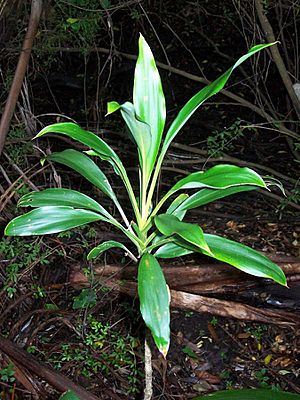Palm Lily facts for kids
Quick facts for kids Palm Lily |
|
|---|---|
 |
|
| Scientific classification | |
| Synonyms | |
|
The Palm Lily, known scientifically as Cordyline rubra, is a beautiful evergreen plant that grows naturally in Australia. It's called a "palm lily" because its leaves can look a bit like a small palm tree, and it has pretty flowers. This plant is a type of shrub that can grow up to about 4 metres (13 feet) tall.
It was first officially described by two German botanists, Christoph Friedrich Otto and Albert Gottfried Dietrich, in 1848. The name rubra comes from a Latin word meaning "red," which likely refers to its bright red berries.
Contents
Where the Palm Lily Grows
The Palm Lily loves warm, moist places. You can find it growing in rainforests and damp eucalyptus forests. Its natural home stretches along the eastern coast of Australia, from a town called Lismore in New South Wales all the way up to near Bundaberg in Queensland.
What the Palm Lily Looks Like
Leaves and Stems
One of the easiest ways to identify Cordyline rubra is by its leaf stems. These stems are usually 5 to 20 centimetres (2 to 8 inches) long and are either flat or slightly curved inwards. The leaves themselves are long and narrow, shaped like an ellipse. They can be 15 to 50 centimetres (6 to 20 inches) long and 3 to 5.5 centimetres (1.4 to 2.2 inches) wide.
Flowers and Fruit
The Palm Lily usually blooms during the summer months. Its flowers are a lovely lilac colour. After the flowers, the plant produces bright red berries. These berries are about 10 millimetres (0.4 inches) across. They grow in clusters called panicles, which can be 10 to 40 centimetres (4 to 16 inches) long.
Growing Palm Lilies
Reproduction
It's quite easy to grow new Palm Lily plants! You can start them from seeds or by taking cuttings from the stems. This means you can cut a piece of the stem and plant it, and it will grow into a new plant.
In Gardens and Homes
While not as common in gardens as some other types of Cordyline plants, the Palm Lily is a great choice for gardens that have moist soil and a bit of shade. It's a tough plant that can handle some neglect, so it's good for beginners. It also makes a nice pot plant for indoors, adding a touch of green to your home. Sometimes, in the wild, it can even mix with another plant called Cordyline petiolaris to create new types of plants.

